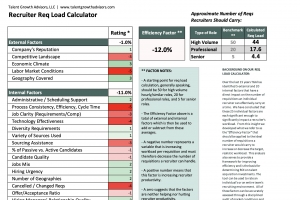Measuring Quality of Hire: Challenges and Opportunities

No one would argue that the talent a company employs play in a crucial role in achieving organizational success. Given this fact then, why don’t more companies measure the quality of their talent?
Oftentimes, the issue comes down to one of accountability; many organizations are simply unsure of who should bear the responsibility of measuring and taking action. Should it be HR or talent acquisition? Or hiring managers? Rather than falling on one particular team, the onus for measuring quality of hire should be on multiple groups – HR, Talent Management, Talent Acquisition, managers themselves as well as senior leaders – who must each do their part. I believe it’s a mistake to begin with the question of who should be accountable. Instead, the best place to start is assessing the current state – without the debate and distraction of where the blame (or credit) should lie.
Still, determining who is responsible is just one of many challenges when it comes to measuring quality of hire; many companies struggle to even start the process. Of course, it can be overwhelming to think about the prospect of measuring quality of hire for all employees across the organization. However, the company doesn’t need to do that. The right approach is to begin by measuring just a segment of the organization – one that drives the greatest business value, like engineers or software developers.
Also critical is understanding that quality of hire should never be subjective – just because a manager is happy with the candidates brought forward or satisfied with their performance doesn’t mean that those individuals will create business value over time – a key component of quality of hire. Instead, it should be based on specific data points that indicate performance among those employees. For many companies, these would be:
- Retention – The length of time an employee has been with the company is a ticket to measuring quality of hire, as the employee should be in place at least two years to begin to understand the value they bring. If an employee quits (for any reason), there is nothing more to measure.
- Performance ratings – Performance ratings are a critical data point for measuring employees. Even when such processes and ratings are imperfect, they are likely imperfect throughout the organization, thus creating a generally fair apples-to-apples calibration of talent.
- Potential ratings – Assessments of potential success in advanced positions is another valuable data point when striving to measure quality of talent over time.
- Promotion history (and/or pay history) – Understanding how an employee has progressed in terms of promotion and salary history within the organization will provide yet another data point about the value they contribute to the organization.
There may be additional business-based data points available for particular roles that would be valuable to consider – such as P&L results, new product launch metrics, net promoter scores, etc. For greatest success, the talent metrics most indicative of quality of hire and how to measure them should be identified and agreed upon by senior leaders.
By analyzing these metrics and involving multiple parties, the organization can gain a better understanding of their quality of hire. But many companies still struggle to get to this state. And organizations that continue to base the success of their recruiting efforts on the opinions of hiring managers, or on a single metric like revenue numbers for sales personnel, will continue to struggle. The solution is to understand the metrics that are most relevant and apply them to, at first, the teams that drive the most value and work from there.
Share this Article
Learn more about our unique approach to Talent Strategy Formulation.



